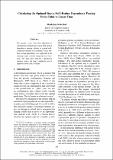Files in this item
Calculating the optimal step in shift-reduce dependency parsing : from cubic to linear time
Item metadata
| dc.contributor.author | Nederhof, Mark Jan | |
| dc.date.accessioned | 2019-06-04T10:30:03Z | |
| dc.date.available | 2019-06-04T10:30:03Z | |
| dc.date.issued | 2019-05-31 | |
| dc.identifier | 259065142 | |
| dc.identifier | 309939cb-5253-4ef3-91c8-bda773cea8f2 | |
| dc.identifier | 85107273555 | |
| dc.identifier.citation | Nederhof , M J 2019 , ' Calculating the optimal step in shift-reduce dependency parsing : from cubic to linear time ' , Transactions of the Association for Computational Linguistics , vol. 7 , pp. 283-296 . https://doi.org/10.1162/tacl_a_00268 | en |
| dc.identifier.issn | 2307-387X | |
| dc.identifier.other | ORCID: /0000-0002-1845-6829/work/58531291 | |
| dc.identifier.uri | https://hdl.handle.net/10023/17811 | |
| dc.description.abstract | We present a new cubic-time algorithm to calculate the optimal next step in shift-reduce dependency parsing, relative to ground truth, commonly referred to as dynamic oracle. Unlike existing algorithms, it is applicable if the training corpus contains non-projective structures. We then show that for a projective training corpus, the time complexity can be improved from cubic to linear. | |
| dc.format.extent | 14 | |
| dc.format.extent | 846011 | |
| dc.language.iso | eng | |
| dc.relation.ispartof | Transactions of the Association for Computational Linguistics | en |
| dc.subject | Formal language theory | en |
| dc.subject | Automata theory | en |
| dc.subject | QA75 Electronic computers. Computer science | en |
| dc.subject | Computational Theory and Mathematics | en |
| dc.subject | T-NDAS | en |
| dc.subject | BDC | en |
| dc.subject | R2C | en |
| dc.subject | ~DC~ | en |
| dc.subject.lcc | QA75 | en |
| dc.title | Calculating the optimal step in shift-reduce dependency parsing : from cubic to linear time | en |
| dc.type | Journal article | en |
| dc.contributor.institution | University of St Andrews. School of Computer Science | en |
| dc.identifier.doi | https://doi.org/10.1162/tacl_a_00268 | |
| dc.description.status | Peer reviewed | en |
This item appears in the following Collection(s)
Items in the St Andrews Research Repository are protected by copyright, with all rights reserved, unless otherwise indicated.

